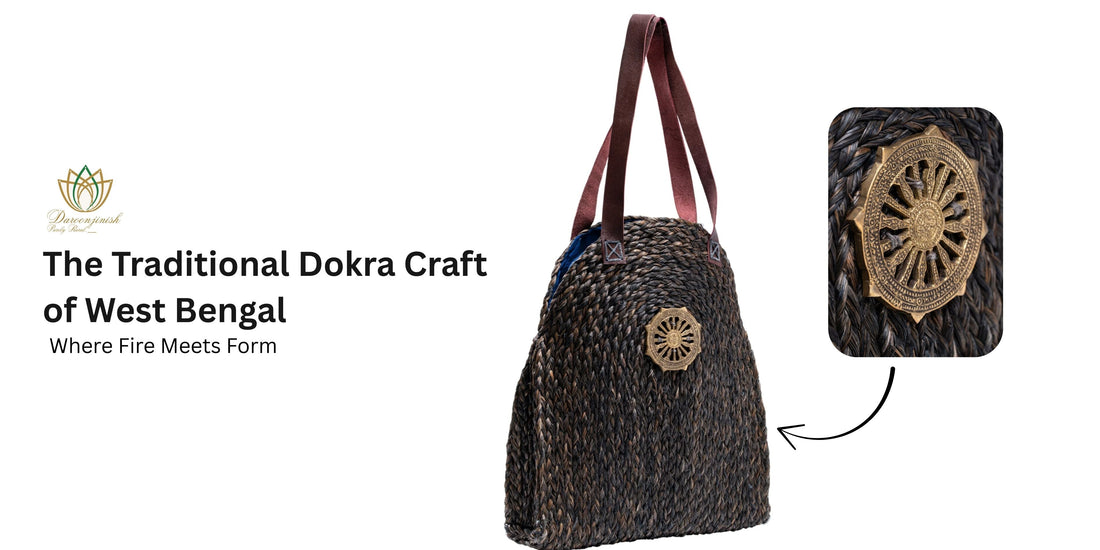
Dokra Craft and the Hands that Keep It Alive
Share
A Craft Forged in Fire, Carried by Time
Before there were machines, there was memory.
And in the villages of West Bengal, that memory took shape through fire, wax, and the skilled hands of tribal artisans—into what we now know as Dokra.
Dokra craft, one of India’s oldest surviving metal art forms, dates back over 4,000 years—tracing its roots to the time of the Indus Valley Civilization. Archaeologists even discovered a Dokra-style dancing girl figurine in Mohenjo-Daro, a timeless symbol of feminine grace forged in bronze.

But Dokra isn’t just an artifact—it’s a living craft, still practiced today in small tribal pockets of Bengal, Odisha, Chhattisgarh, and Jharkhand.
How Is Dokra Made? The Ancient ‘Lost Wax’ Method
The magic of Dokra lies in its technique: the lost-wax casting method (known locally as cire perdue).
Here’s how it works:
- Artisans sculpt a model using beeswax or resin, carefully shaping each detail—every curve, every motif.
- They then coat it in layers of clay and sun-dry it until the mold hardens.
- Once ready, the mold is heated; the wax melts away, leaving a hollow cavity.
- Molten metal (usually brass or bronze) is poured in, filling the space left by the wax.
- After cooling, the clay shell is broken—and the final metal piece is revealed, never to be replicated again.

This means no two Dokra pieces are ever the same. Each carries the uniqueness of its maker, and a moment of time captured in metal.
Dokra in Today’s World: Where Tribal Art Meets Modern Homes
Traditionally, Dokra pieces were sacred—used in rituals, offerings, and village storytelling. They often depicted animals, tribal deities, fertility symbols, and nature spirits.
Today, Dokra has found a new place—in homes around the world as décor, jewelry, sculpture, and accents that blend heritage with minimalism. Its raw texture, earthy gold tones, and symbolic patterns make it timelessly elegant for modern spaces.
Dokra x Daroonjinish: Carrying Craft Forward
At Daroonjinish, we believe heritage isn’t just meant to be displayed—it’s meant to be lived with. That’s why we’re introducing handcrafted Dokra accents into our basket and bag collections, fusing tradition with utility.
 Imagine a natural Sabai basket, woven by women in Bengal, adorned with a handcrafted Dokra clasp or charm. Or a jute sling bag detailed with a Dokra elephant symbolizing wisdom and protection.
Imagine a natural Sabai basket, woven by women in Bengal, adorned with a handcrafted Dokra clasp or charm. Or a jute sling bag detailed with a Dokra elephant symbolizing wisdom and protection.
This isn’t just design—it’s dialogue.
Between past and present. Between tribal hands and urban homes. Between tradition and transformation.
Why It Matters
Supporting Dokra artisans means supporting livelihoods rooted in ancient wisdom. It means protecting a craft passed down through generations—by people who don’t read from books but work from memory.

It also means choosing pieces that don’t follow trends but tell stories. Products that carry soul, substance, and sustainability.
Final Thoughts
Dokra is more than an art—it’s an offering from fire and hand, made slowly, purposefully, and beautifully imperfect. And in our fast-moving world, that matters.
At Daroonjinish, we’re proud to celebrate and integrate this craft into our creations—not as an accessory, but as an identity.
Because the future of design is not mass-made. It’s handmade.
And it starts with remembering where we come from.
